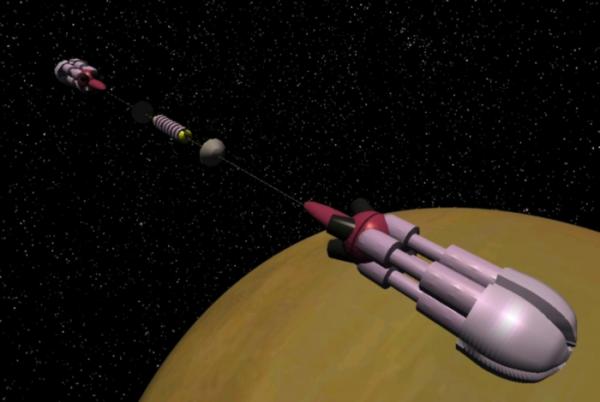BY LETTER
Interstellar Singleship
Technology > Application > Transportation > Interstellar Transport
Technology > Application > Transportation > Ships
Technology > Technology Levels > Ultratech
Technology > Application > Transportation > Ships
Technology > Technology Levels > Ultratech
 Image from Phil B | |
| This interstellar singleship has thrust motors at each end, and the crew compartment at the centre, with radiation shielding protecting it in both directions | |
An interstellar singleship is defined as a small, light duty interstellar craft that can be operated for long periods of time by a single individual. Single-manned craft which operate within the confines of planetary systems have existed since the Interplanetary age, but are generally far less sophisticated than the interstellar equivalent.
Typical interstellar singleships carry a crew component of 1 to 5 sophonts. They are not specifically designed for high acceleration, but on average can manage accelerations of up to 50g for short periods of time depending on the tolerance of the crew and onboard equipment. These small craft are usually found in the hands of nearbaseline equivalent sapients and because of that, they almost never contain technology more advanced than mature nanotech (excluding - if present, of course - the monopoles required for the engine).
The typical singleship design has a crew cabin and at least two engine modules. These are arranged in a line, with one engine pulling a tungsten shielding block, which in turn pulls the crew cabin on long tethers, and the crew cabin pulling the second engine module. This allows for braking without turning the ship around mid-flight, as such a maneuver would expose the crew cabin to possible impact with interstellar debris. At relativistic velocity, even a tiny bit of debris is a potentially deadly missile.
The leading surface of the engine modules is devoted to shielding the entire craft. Many systems exist to handle these duties, but the most successful concept is a cloud of nanotech devices that extends many kilometers in front of the singleship, coupled with a coolant cloud released from the front of the engine. These two clouds are constantly magnetically recycled through the engine module. This allows any matter the vessel intercepts to be collected for fuel (if the vessel uses Fusion, AMAT, or monopole reactor drives) and breaks down larger bits of interstellar debris to a more manageable size as it impacts the nanobot cloud.
Crew compartments require heavy radiation shielding, as they are directly in the exhaust plume of the running engine. This is usually accomplished with a tungsten block which is used as a shadow shield to protect against the gamma ray output of the engine.
When inside a stellar system, most singleships use a magnetic sail drive system that combines the power of both engine modules, and most also use this for braking upon arrival at their destination. Other braking systems have the forward facing engine turn over in mid-flight, and connect to the crew compartment. The engine is then brought up to power facing in the opposite direction. The exhaust plume then acts to deflect incoming debris, or ionize anything it can't deflect, so the magnetic sail can deflect it.
Most singleships have a sentient subsophont expert system pilot software suite. This software suite generally contains a stellar cartography application, a wormhole link chart, and a short description of each destination. This information can be updated automatically at nearly any spaceport. This expert system also maintains the crew of the vessel while they are in nanostasis - if such is used on the vessel.
 Image from Steve Bowers |
The range of a singleship is entirely dependent on the type of engine and the environment. If the ship uses a fusion reactor, whether monopole catalyzed or not, as long as the ship can collect enough hydrogen with its magnetic shield/scoop, it can continue running. If the ship has conversion drive, as long as baryonic matter is fed to the reactor, it will continue running. Amat reactors require, of course, antimatter, which can be hard to find. Most modern exploratory singleships, and almost all modern long-range singleships use an expensive, transapient designed conversion drive.
The crew compartment of a singleship varies from ship to ship, to suit the pilot's needs. Most contain a small nanofac, a nanostasis unit, and an internal virch world to amuse the crew while they are in stasis. Most crew compartments are surrounded in incremental layers of SiCHON material, to be used as raw material for the ship's nanofac.
Contained in the typical singleship's archive are the design specification for a multitude of useful objects that might be required while the vessel is under acceleration for decades of travel. These objects can be created by the ship's onboard nanofac. Typically, this includes a plethora of high-acceleration probes with radio data linkage back to the vessel, small orbit-to-surface lander craft (with the specification that they can reach orbit again once they land on the surface of most biont-tolerable worlds), a gigantic solar collector array usable to charge up a nanoflywheel array and a multitude of other devices.
With the onboard nanofac, it is not impossible to completely re-engineer the crew compartment once it has arrived at its destination. The onboard nanofac has the capability to convert local matter in the environment into usable material, if, at the very least, amounts of carbon can be found. Once the ship arrives at a destination, probes can be used to gather asteroid material, and the onboard nanofac can convert both the singleship and the local asteroid material into quite an extensive habitat. Some rather large habitats began existence as just one singleship, several dyson spheres in outer reaches of the Solar Dominion began as singleships half-a-dozen millennia ago.
 Image from Steve Bowers | |
| singleship LookfarII orbiting Rana c | |
Vingette: The voyage to Hemel Dur:
There's something special about rain. The fact that something as simple as water vapor condensing and then falling to the ground can invoke a certain kind of feeling in a person- a kind of relaxation where nothing but your immediate surroundings exist and the things you should probably worry about seem so far away. It's probably why the virtual environment I've built my exoself around involves rain no matter what configuration I'm trying out each month- whether it be some type of forest or a lit up cityscape bathed in perpetual night. It allows me to better focus on what I'm doing rather than worrying about what's going on in the ril. Seeing as reality is currently the inside of a biostasis pod, that's not exactly difficult.
The Singleship had held up remarkably well in the past century and a half, and the fusion engine I had retrofitted into a conversion drive hadn't given me too many issues. This was a good thing too, since I had to trade the rights to one of my more popular virch environments to get my hands on the monopoles. Leaning back from my virtual desk, I stared at a furry animal of unknown origin that was probably snagged from my creature library at random. I watched as it tried to find shelter in the nearby trees from the unending downpour happening outside the window. Turning back to the desk, a multitude of terminal windows greeted me, razor thin opaque rectangles of light anchored in space above the desk; archaic I know. Scrolling through the newly arrived content from home, I swiftly got rid of text articles and vidfeeds pertaining to current events there. After all, they were more than a century and a half out of date. Sifting further, I found what I was looking for: the testimonials and holo-letters from my circle of friends.
That circle wasn't too large these days. I had a falling out with several of them after I announced my plans to traverse the Hemel Deur ascension maze because after all, it wasn't too uncommon for participants to come out irreparably changed, and a few more had even been confirmed to have died while inside. Still, the value of knowledge and information and the unending desire to know everything was almost too much sometimes. I had made sure that the associations were at the forefront of my mind at all times and as such it drove every decision I made. It was hard enough to make others understand and even so, the friends who still talked to me on a regular basis didn't comprehend my need- not really- but they understood how important it was to me and supported my decision to go. Still, they expressed their concern about me not just sending an upload or partial and then became confused as I tried to explain that it had to be me- all of me, the sentience that inhabits this body and no other. So here I was, still nearly 60 light-years from home and still about four months from the nearest wormhole mouth, with no idea what was in store for me when I got there.
Waving the terminals away I stood up and wandered over to the (virtual) "window". No one really knows what goes on inside the famous Hemel Deur. It is a massive cube shaped habitat, the size of a small moon, made up of smaller cube shaped structures that all spiral in on each other, meeting at a spherical center point. Everyone who's come out the other end has told of a different experience- meaning the maze is tailored to every being who goes in, and the things one encounters vary- from real world scenarios one must solve, to mental and physical exercises with each problem being open-ended, and seemingly endless ways to approach and solve each one go them.
I sighed and sat down on my favorite cushion. It wasn't worth worrying about when I still had several months before I got there. I called up the shipmind I had installed, it shimmered into existence before me, taking the form of a large penguin.
"How may I be of service?" It asked, preforming a small bow.
"I was wondering if we could make a small course correction." I pulled up the ship's current trajectory in my periphery, added a correction beside it, and unceremoniously directed it at the shipmind. "If we do this it should shave about a month off our remaining time." The shipmind spent a second absorbing the information.
"This should work, I'll make sure it's implemented right away." It did a silly little salute and then dissolved into the air. Materializing the book I was in the middle of, I opened it up and let the pages take me.
Related Articles
Appears in Topics
Development Notes
Text by ROM 65536
Initially published on 05 December 2005.
vignette by BNKirby added may 2022
Initially published on 05 December 2005.
vignette by BNKirby added may 2022






